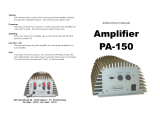
OWNER' S MAN U A L - 2
INTRODUCTION
WHAT’S IN THE BOX
• (1) Amplifier
• (2) Allen wrenches 2mm & 3mm
• (1) Hardware kit
• (1) Owner’s manual
• (1) Window decal
• (1) Unique individual amplifier birth certificate
PRACTICE SAFE SOUND™
Continuous exposure to sound pressure levels over 100dB may cause
permanent hearing loss. High power automotive sound systems can
generate sound pressure levels in excess of 130dB. When playing
your system at high levels, please use hearing protection and avoid
long term exposure.
RECORD YOUR SERIAL NUMBER AND DATE
To ensure your warranty (see back cover), please record the following
information regarding your new amplifier.
Model: __________________________________
Serial Number: __________________________________
Date of Purchase: __________________________________
Purchased from: __________________________________
Thank you for your purchase of Orion’s amplifier. Each Orion amplifier
is designed to be the leader in its class offering ease of use, advanced
features, and the most power. Orion amplifiers are designed as the best
affordable high end car audio amplifier money can buy. Listed below are
the features of these new Orion amplifiers.
• XTR500.4 -
90 Watts per channel, four-channel amplifier with
built-in high-pass and low-pass 12dB/octave crossover and Bass Boost.
The XTR500.4 is capable of 6, 5, 4, 3 or 2 channel operation with a
maximum power capability of 500 Watts RMS into two 4Ω Bridged Loads.
• XTR750.4 -
135 Watts per channel, four-channel amplifier with
built-in high-pass and low-pass 12dB/octave crossover and Bass Boost.
The XTR750.4 is capable of 6, 5, 4, 3 or 2 channel operation with a
maximum power capability of 750 Watts RMS into two 4Ω Bridged Loads.
• XTR1000.4 -
165 Watts per channel, four-channel amplifier with
built-in high-pass and low-pass 12dB/octave crossover and Bass Boost.
The XTR1000.4 is capable of 6, 5, 4, 3 or 2 channel operation with a
maximum power capability of 1000 Watts RMS into two 4Ω Bridged Loads.
• XTR1700.4 -
250Watts per channel, four-channel amplifier with
built-in high-pass and low-pass 12dB/octave crossover and Bass Boost.
The XTR1700.4 is capable of 6, 5, 4, 3
or 2 channel operation with a
maximum power capability of 1700 Watts RMS into two 4Ω Bridged Loads.
• XTR2500.4
400Watts per channel, four-channel amplifier with
built-in high-pass and low-pass 12dB/octave crossover and Bass Boost.
The XTR2500.4 is capable of 6, 5, 4, 3 or 2 channel operation with a
maximum power capability of 2500 Watts RMS into two 4Ω Bridged Loads.
The installation of all Orion components will determine the overall
performance result. Improper installation will not only limit the
performance of your Orion system but also potentially compromise
the reliability of this amplifier. To ensure proper sonic results and
component reliability, please refer to your authorized Orion dealer
for installation assistance or advice. If you decide to perform the
installation yourself, be sure to read the entire manual before begin-
ning the installation.
• (1) Remote Kit (Remote Gain Control with cable)























